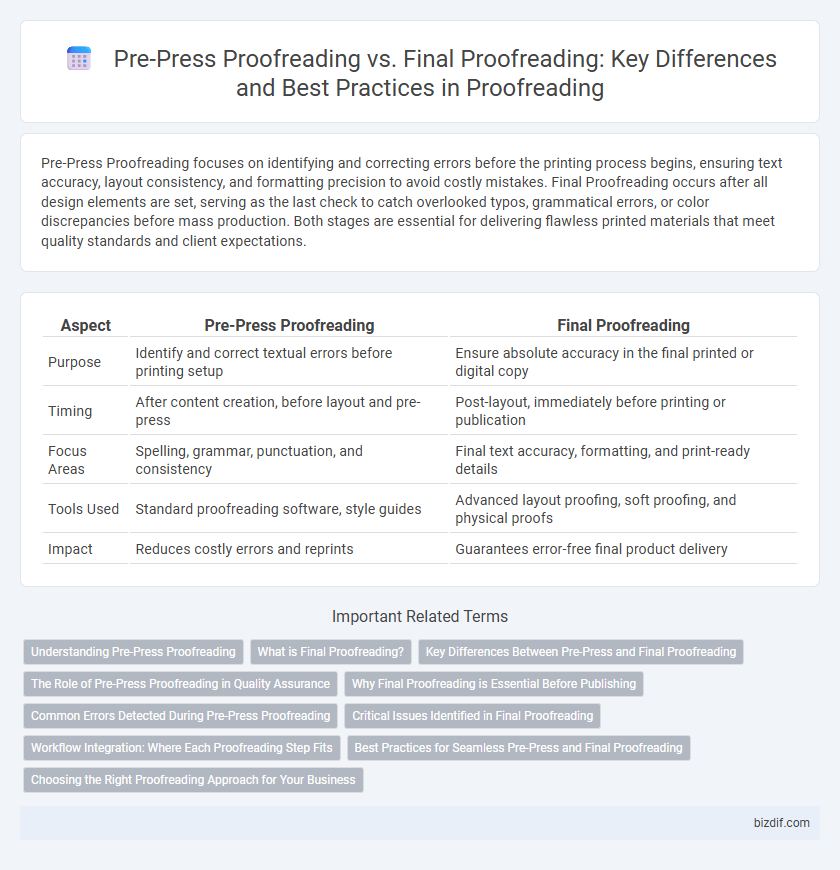Pre-Press Proofreading focuses on identifying and correcting errors before the printing process begins, ensuring text accuracy, layout consistency, and formatting precision to avoid costly mistakes. Final Proofreading occurs after all design elements are set, serving as the last check to catch overlooked typos, grammatical errors, or color discrepancies before mass production. Both stages are essential for delivering flawless printed materials that meet quality standards and client expectations.
Table of Comparison
| Aspect | Pre-Press Proofreading | Final Proofreading |
|---|---|---|
| Purpose | Identify and correct textual errors before printing setup | Ensure absolute accuracy in the final printed or digital copy |
| Timing | After content creation, before layout and pre-press | Post-layout, immediately before printing or publication |
| Focus Areas | Spelling, grammar, punctuation, and consistency | Final text accuracy, formatting, and print-ready details |
| Tools Used | Standard proofreading software, style guides | Advanced layout proofing, soft proofing, and physical proofs |
| Impact | Reduces costly errors and reprints | Guarantees error-free final product delivery |
Understanding Pre-Press Proofreading
Pre-Press Proofreading involves meticulously reviewing digital and printed materials before the final printing stage to identify and correct errors in text, layout, and design. This step ensures accuracy in typography, color consistency, and alignment, preventing costly mistakes during production. Emphasizing Pre-Press Proofreading improves overall print quality and guarantees that content meets brand standards before mass distribution.
What is Final Proofreading?
Final proofreading is the last step in the editing process before printing or publishing, focusing on identifying and correcting any remaining typographical, grammatical, or formatting errors. It ensures that the document is error-free, consistent, and polished, verifying that all pre-press corrections have been accurately implemented. This stage is crucial for maintaining the publication's professionalism and preventing costly mistakes or reprints.
Key Differences Between Pre-Press and Final Proofreading
Pre-Press Proofreading focuses on detecting errors in layout, typography, and image placement before printing begins, ensuring all design elements align with brand standards. Final Proofreading is the last review stage, emphasizing accuracy in text, grammar, and factual data to prevent costly mistakes in the finished product. The key difference lies in Pre-Press Proofreading's emphasis on visual and technical formatting versus Final Proofreading's focus on linguistic and content precision.
The Role of Pre-Press Proofreading in Quality Assurance
Pre-Press Proofreading serves as a critical quality assurance step by identifying and correcting errors before the printing process, ensuring content accuracy and layout consistency. It focuses on detecting typographical mistakes, formatting issues, and color discrepancies that could impact the final product. This early intervention reduces costly revisions and maintains high standards in publishing workflows.
Why Final Proofreading is Essential Before Publishing
Final proofreading is essential before publishing to ensure all content is error-free, preventing costly mistakes in print or digital distribution. It verifies that corrections from pre-press proofreading have been accurately implemented and that layout, design, and text align with project specifications. This critical step safeguards brand credibility and enhances the quality of the final product.
Common Errors Detected During Pre-Press Proofreading
Pre-press proofreading commonly detects errors such as typographical mistakes, incorrect font styles or sizes, misaligned text, and color inconsistencies that can impact print quality. These issues often include missing images, improper bleeds, and layout problems that disrupt the final design aesthetics. Catching these errors early ensures smoother transitions to final proofreading and minimizes costly print defects.
Critical Issues Identified in Final Proofreading
Critical issues identified in final proofreading often include typographical errors, color inconsistencies, and layout misalignments that were overlooked during pre-press proofreading. Final proofreading acts as the last checkpoint to ensure all corrections are accurately implemented, preventing costly print errors and maintaining brand integrity. This stage verifies that all text, images, and design elements meet publishing standards before mass production.
Workflow Integration: Where Each Proofreading Step Fits
Pre-press proofreading occurs early in the production workflow, focusing on correcting text and layout errors before printing plates are made, ensuring that design specifications and editorial standards are met. Final proofreading takes place after printing, aimed at detecting any remaining typographical or color consistency errors on the physical proof to guarantee the finished product's accuracy. Integrating both steps into the workflow minimizes costly revisions, enhances quality control, and streamlines the transition from digital files to printed materials.
Best Practices for Seamless Pre-Press and Final Proofreading
Pre-press proofreading focuses on identifying typographical errors, layout inconsistencies, and color issues early to prevent costly revisions during final production, ensuring the design aligns with brand guidelines and printing specifications. Final proofreading involves a meticulous review of the near-complete proof, checking for any overlooked text errors, formatting issues, and color accuracy under production conditions. Best practices include using high-resolution proofs, cross-referencing against original content, and involving multiple reviewers to guarantee a seamless transition from pre-press to the final print stage.
Choosing the Right Proofreading Approach for Your Business
Pre-press proofreading focuses on catching errors in text, layout, and design before the printing process, ensuring accuracy and consistency to avoid costly mistakes. Final proofreading occurs after print samples or proofs are produced, verifying color fidelity, image quality, and final text alignment to guarantee a polished product. Choosing the right proofreading approach depends on your business needs, budget, and production timeline, with a combination often providing the best assurance of error-free, professional-quality output.
Pre-Press Proofreading vs Final Proofreading Infographic

 bizdif.com
bizdif.com